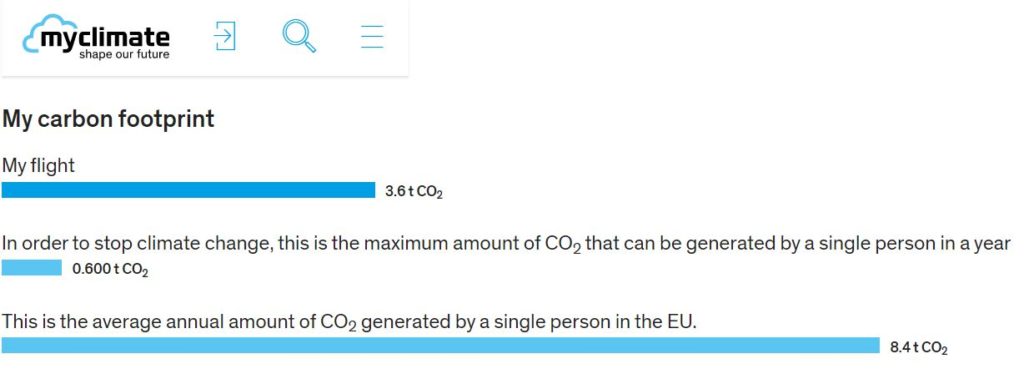By the time this post goes live, Christian and I will be high above the clouds on our way to Japan. I will have just returned from a conference in New Orleans, and I will be looking forward to a trip out to Zion National Park for a half marathon immediately after we get back to the US. Ultimately, this means a lot of flight time for me and a massive addition to my carbon footprint.
For years I have wrestled with the moral quandary of weighing my love of travel and seeing beautiful places in the world with the knowledge that continued air travel to those places will likely hasten their destruction. That knowledge has not stopped me from traveling (at least not yet), but it does result in more frequent pangs of guilt every time I board a plane.
So here I am in the same position as many environmentalists have been slammed for globe-trotting for years. When Al Gore travels the world for the Climate Reality Project[1] and his work related to “An Inconvenient Truth,”[2] critics call him a hypocrite for flying frequently and therefore contributing to climate change. Similarly, before they were making headlines with “Megxit,” the Duke and Duchess of Sussex were under similar criticism for traveling on Elton John’s private jet for vacation while at the same time promoting environmental causes on their Instagram account.[3]
Some argue that blaming travelers for their carbon footprint “shifts the blame from the actually guilty parties – oil companies, and the governments and financial systems who support them – to the environmental advocate.”[4] While yes, there is merit in this argument, and yes, I agree that we need to look at increasing efficiency in the sectors that use the most energy (like building operations), I don’t believe that finger-pointing at big polluters and big users excuses the rest of us from making responsible decisions in our own spheres of influence.

Flygskam!
In addition to her scathing speech at the United Nations last fall, Swedish climate activist Greta Thunberg made headlines by making her trip to America by boat instead of plane.[6] She spent two weeks traveling from the UK to New York on a 60-foot zero-emission yacht with solar panels and hydro generators. While she said she doesn’t expect everyone to cross the ocean in a boat like she did, her family has embraced land and water travel over air. In 2016, she convinced her mother, an international opera singer, to give up her job because of the associated carbon footprint.[7]
Greta is not alone in what the Swedish are calling “flygskam,” or “flight shame.” The number of Swedes who are opting for train travel over flying doubled over an 18-month period of time, according to a 2019 report. However, this trend seems to relate only to domestic travel, where trains are an alternative; Sweden remains one of the countries with highest flying rates per person – five times that of the average global citizen – and instances of international flights have not decreased.[8]
As for Americans, many people need to fly for work or don’t have enough vacation time to allow for slower road or water travel as an alternative. It also goes without saying that the state of our rail system in this country leaves much to be desired. For people who do fly but also experience flygskam, the BBC has assembled a list of suggestions on how to reduce your flight-related carbon footprint:[9]
- Don’t fly if you don’t have to (first step: reduce)
- Pack light (more weight equals more fuel)
- Fly direct (more fuel is used on takeoff and landing than while the plane is cruising)
- Sit in economy class (smaller seats can take more people on the same trip)
- Different airlines use more fuel than others – pick one that economizes fuel (it may be true, but they did not share any information on how to check on these statistics)
- Use your local airport (you increase your carbon footprint by driving to an airport that is farther away)
- Offset your flight’s carbon footprint

Carbon Offsets for Your Flight
I have written about carbon offsets on this blog before, but in the context of third-party electricity suppliers and how they provide “green” energy plans.[11] “Green” electricity plans don’t actually send electrons generated by renewable sources to your house – that’s impossible unless you’re connected to a micro-grid powered by renewables (in which case you wouldn’t be opting for a “green electricity plan.”) Instead, they offset the carbon produced by your local (largely fossil fuel-powered) generation sources by putting money into the development of solar, wind, and other renewable generation. The carbon offsets in your electricity bill financially support the future addition of renewable energy generation sources to the grid.
Similarly (since it is impossible to put the carbon back into the jet), many flight offset websites put your money toward sustainable development projects that will benefit the global environment in the long term. Examples of these projects include managing reforestation initiatives, preserving wildlife sanctuaries, and providing clean-burning cook stoves to families in developing countries.
The numbers you get from these calculators will vary by site. They use different algorithms, and the good ones will explain their methodology. An important point to consider is that calculators may or may not account for high-altitude, non-CO2 effects, such as increases in ozone from nitrogen oxide emissions. I calculated my upcoming travel footprint on websites that did[12] and did not[13] include non-CO2 effects. The calculator that includes non-CO2 effects roughly doubled my total impact.
The offset rate (dollars per ton) also varies per site, but what I saw was still cheaper than expected. My total CO2 from eleven flights over three upcoming trips comes out to 5.3 tons of CO2 (with non-CO2 factors included and flying economy class, of course). The offset associated with that much CO2 according to myclimate.org is $147.

There are critics of travel offsets who (correctly) state that the best thing to do is not to travel at all; that carbon offset projects won’t realize their environmental benefits for years down the road, while people are burning jet fuel now; that it’s just a way for rich people to wash away their travel-related guilt.[15] While I won’t refute any of those statements, I will also point out that the guilt we globe-trotters feel can help to fund development projects that might never get off the ground otherwise.
As for what I plan to do next, I still want to look around a little bit more before making a decision on which website I will use and which project(s) I will support with my offset dollars. That being said, my intention is that by the time you’re reading this post, I will have contributed money toward something that will offset my significant upcoming travel footprint.
Have you ever bought or looked into travel offsets? I’d love to hear about your experience.
Thanks for reading!
[1] https://www.climaterealityproject.org/
[2] https://www.imdb.com/title/tt0497116/
[3] https://www.bbc.com/news/uk-49408915
[4] https://blog.usejournal.com/flying-isnt-the-source-of-our-global-warming-problems-so-let-s-focus-our-energies-elsewhere-2dda9003ee72
[5] https://imgur.com/gallery/5qMCbEO
[6] https://time.com/5663534/greta-thunberg-arrives-sail-atlantic/
[7] https://www.classicalmpr.org/story/2019/09/25/malena-ernman-opera-greta-thunberg
[8] https://www.dw.com/en/swedes-switch-to-trains-due-to-global-warming/a-49033136-0
[9] https://www.bbc.com/news/av/science-environment-48206946/how-to-reduce-your-carbon-footprint-when-you-fly
[10] https://www.bbc.com/news/science-environment-49349566
[11] https://radicalmoderate.online/third-party-electricity-suppliers-part-1/
[12] https://co2.myclimate.org/en/flight_calculators/new
[13] https://applications.icao.int/icec
[14] https://www.myclimate.org/
[15] https://www.wired.co.uk/article/carbon-offsetting-uk-flights
1 Comment
Passport Overused · January 26, 2020 at 10:14 am
Great post😀